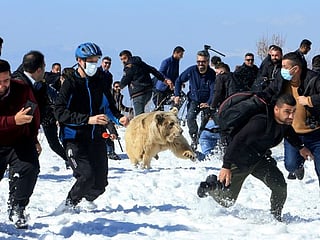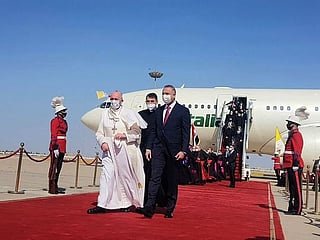Iran’s proxies in Iraq threaten US with more sophisticated weapons
Iran, weakened by harsh sanctions, is using militias to step up pressure on US

Baghdad: The United States is grappling with a rapidly evolving threat from Iranian proxies in Iraq after militia forces specialised in operating more sophisticated weaponry, including armed drones, have hit some of the most sensitive US targets in attacks that evaded US defences.
At least three times in the past two months, those militias have used small, explosive-laden drones that divebomb and crash into their targets in late-night attacks on Iraqi bases - including those used by the CIA and US Special Operations units, according to American officials.
Gen. Kenneth McKenzie Jr., the top American commander in the Middle East, said last month that the drones pose a serious threat and that the military was rushing to devise ways to combat them.
Iran - weakened by years of harsh economic sanctions - is using its proxy militias in Iraq to step up pressure on the United States and other world powers to negotiate an easing of those sanctions as part of a revival of the 2015 nuclear deal. Iraqi and American officials say Iran has designed the drone attacks to minimise casualties that could prompt US retaliation.
Michael Mulroy, a former CIA officer and top Middle East policy official at the Pentagon, said that with technology provided by Iran’s Quds Force - the foreign-facing arm of Iran’s security apparatus - the drones are rapidly becoming more sophisticated at a relatively low cost.
“The drones are a big deal, one of the most significant threats our troops there face,” he said.
A senior Iraqi national security official said the drones posed a challenge but were tools, not the heart of the problem.
“This is a means of pressure,” said the official, who asked not to be identified so he could speak freely about Iran. “Iran is suffocating economically. The more it suffers, the more these attacks increase,” he added. “The problem is the conflict between the US and Iran.”
Iran has used proxy militias in Iraq since 2003 to influence Iraqi politics and threaten the United States outside its borders.
300 attacks
Since late 2019, Iran-backed Iraqi Shiite militias have conducted more than 300 attacks against US interests, killing four Americans and about 25 others, mostly Iraqis, according to a Defence Intelligence Agency assessment published in April. In the last year, a proliferation of previously unknown armed groups have emerged, some claiming responsibility for rocket attacks on US targets.
The increased precision of the drone strikes this year marks an escalation from the more common Katyusha rocket attacks that US officials have viewed more as harassment. Those attacks, launched from mobile launchers, have been aimed at the US Embassy in Baghdad’s Green Zone and military bases where some 2,500 US forces and thousands of US military contractors operate.
In contrast, some American analysts say that the militants are now targeting sites, even specific aircraft hangars, where sophisticated armed MQ-9 Reaper drones and contractor-operated turboprop surveillance aircraft are stationed in an attempt to disrupt or cripple the US reconnaissance capability critical to monitoring threats in Iraq.
The United States has used Reapers for its most sensitive strikes, including the killing of Iran’s top security and intelligence commander, Maj. Gen. Qassem Soleimani, and Abu Mahdi Al Muhandis, a senior Iraqi government official and a leader of Iraq’s militia groups, in Baghdad in January 2020.
While the United States has installed defences to counter rocket, artillery and mortar systems at installations in Iraq, the armed drones fly too low to be detected by those defences, officials said.
Shortly before midnight on April 14, a drone strike targeted a CIA hangar inside the airport complex in the northern Iraqi city of Irbil, according to three American officials familiar with the matter.
Covert nature
No one was reported hurt in the attack, but it alarmed Pentagon and White House officials because of the covert nature of the facility and the sophistication of the strike, details of which were previously reported by The Washington Post.
A similar drone attack in the early morning hours of May 8 on the sprawling Ain al-Asad base in western Anbar province - where the United States also operates Reaper drones - also raised concerns among American commanders about militias’ shifting tactics. The attack caused no injuries but damaged an aircraft hangar, according to Col. Wayne Marotto, a spokesperson for the US-led coalition in Iraq.
Three days later, another drone struck just after midnight at an airfield in Harir, north of Irbil, that is used by the military’s highly secretive Joint Special Operations Command. That explosive-laden drone crashed, causing no injuries or damage, coalition officials said, but fuelled the growing worries.
While many attacks against US targets almost immediately generate claims of responsibility from militias, the more complex and longer-range drone strikes have not, a further indication that Iran is behind them, according to American officials and independent analysts.
'Very sophisticated attacks'
“There is increasing evidence that Iran is trying to have or has created some special groups, new ones that are able to conduct very sophisticated attacks against the US interests,” said Hamdi Malik, an associate fellow with the Washington Institute for Near East Policy who focuses on Shiite militias.
In addition to the attacks on US targets in Iraq, an armed drone believed to have been launched from the south of Iraq hit the Saudi royal palace in Riyadh in January.
While visiting northeastern Syria last month, McKenzie, the top American commander for the region, said military officials were developing ways to disrupt or disable communications between the drones and their operators, bolster radar sensors to identify approaching threats more rapidly, and find effective ways to down the aircraft.
In each of the known attacks in Iraq, at least some of the drones’ remnants have been partially recovered, and preliminary analyses indicated they were made in Iran or used technology provided by Iran, according to the three American officials familiar with the incidents.
These drones are larger than the commercially available quadcopters - small helicopters with four rotors - that Daesh used in the battle of Mosul but smaller than the MQ-9 Reapers, which have a 66-foot wingspan. Military analysts say they carry between 5 to 30kgs of explosives.
Iraqi officials and US analysts say that while cash-strapped Iran has reduced funding for major Iraqi militias, it has invested in splitting off smaller, more specialised proxies still operating within the larger militias but not under their direct command.
American and Iraqi officials and analysts trace the increased unpredictability of militia operations in Iraq to the US killing of Soleimani and the Iraqi militia leader.
“Because the Iranian control over its militias has fragmented after the killing of Qassem Soleimani and Abu Mahdi Muhandis, the competition has increased among these groups,” said Malik, the Washington Institute analyst.
Sign up for the Daily Briefing
Get the latest news and updates straight to your inbox









